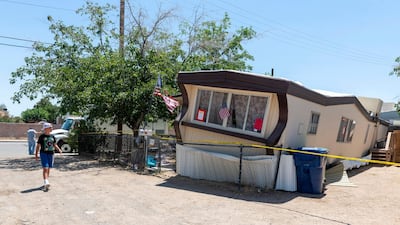California's governor has requested a Presidential Emergency Declaration from Donald Trump following two devastating earthquakes in his state.
In a letter to President Trump on Saturday, Gavin Newsom said the impact of the two earthquakes following a string of natural disasters including unprecedented wildfires and mudslides warranted federal help.
"I have determined that the damages caused by the July 4 and 5 earthquakes, are of such severity and magnitude that continued effective response is beyond the capabilities of the state and affected local governments," he wrote.
"Supplemental federal assistance is necessary to save lives and to protect property, public health and safety".
Southern California was hit by a second powerful earthquake on Friday night that cracked buildings, set fires, broke roads and caused several injuries.
The quake, which followed 6.4-magnitude temblor in the Mojave Desert on Thursday, was the largest the region has experienced in at least 20 years and was followed by a series of large and small aftershocks.
It hit at 8.19pm and was centred about 18 kilometres from the city of Ridgecrest in the same area where the previous quake hit. But it was felt as far north as Sacramento, as far east as Las Vegas and as far south as Mexico.
Early magnitude estimates from the US Geological Survey varied between 6.9 and 7.1.
The area in and around Ridgecrest, already trying to recover from the previous tremor, took the brunt of damage.
Megan Person, director of communications for the Kern County Fire Department, said there were reports of numerous injuries and fires, but she did not have details.
The county opened an emergency shelter. Meanwhile, a rockslide closed State Route 178 in Kern River Canyon, where photos from witnesses also showed that a stretch of roadway had sunk.
San Bernardino County firefighters reported cracked buildings and one minor injury.
In Los Angeles, 240 kilometres away, offices in skyscrapers rolled and rocked for at least 30 seconds.
California is prone to earthquakes because of the San Andreas fault line running through the state. The long period since a major tremor had raised fears that one was imminent as pressure builds up from the movement of the Pacific and North American tectonic plates.
California Governor Gavin Newsom activated the state's Office of Emergency Services operations centre "to its highest level" after Friday's quake.
"The state is co-ordinating mutual aid to local first responders," he said.
Lucy Jones, a seismologist at the California Institute of Technology and a former science adviser at the Geological Survey, tweeted that Thursday's earthquake was a "foreshock" and that Friday's quake was on the same fault system as the earlier quake.
"You know we say we have a 1 in 20 chance that an earthquake will be followed by something bigger? This is that 1 in 20 time," she tweeted.
Firefighters around Southern California were mobilised to check for damage.
The Six Flags Magic Mountain park in Santa Clarita said in a tweet Friday night it had stopped running rides in after the earthquake.
"The safety of our guests and employees is our top priority and as a precautionary measure, we are conducting an extensive visual, structural, and operational safety checks on all of the rides before re-opening," the park said on Twitter.
Disneyland had evacuated rides as the park conducted safety checks, according to the Hollywood Reporter. The park's mobile app had marked all rides as "temporarily closed" on Friday night.
The quake came as communities in the Mojave Desert assessed damage and made emergency repairs to cracked roads and broken pipes from the earlier tremor.
Hours earlier, seismologists had said that quake had been followed by more than 1,700 aftershocks and that they might continue for years.
Ms Jones said aftershocks from the new main quake could occur for three years.
California is partnering with the federal government to build the statewide earthquake warning system, with the goal of turning it on by June 2021. The state has already spent at least $25 million (Dh92m) building it, including installing hundreds of seismic stations throughout the state.
This year, Governor Newsom said the state needed $16.3m to finish the project, which included money for stations to monitor seismic activity, plus nearly $7m for "outreach and education". The state legislature approved the funding last month.

